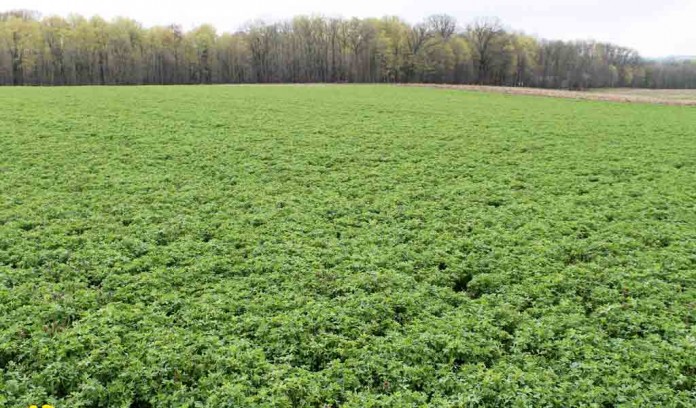Weeds are inevitably present whenever a stand of alfalfa is established. The species present and the density of the weeds will determine the success of the new seeding.
In most cases, weeds will not severely damage the stand, but they certainly can cause significant stand reductions at times. Weeds may also reduce the quality of that first cutting, and poisonous weeds may be present that may cause animals to become ill.
Weeds during the establishment phase my dictate how long that stand will be kept. Managing weeds in seedling alfalfa can significantly reduce those stand losses and preserve the quantity and quality of the first and subsequent cuttings.
Choose wisely
Choosing the correct herbicide for the weeds present is essential to successfully controlling weeds in seedling alfalfa. Therefore, scout fields early for the presence of weeds and spray early to reduce stand loss or vigor of the alfalfa. When seeding alfalfa in the spring, summer annual weeds are the biggest problem. If perennial weeds were not properly controlled prior to planting the alfalfa, then they may have to stay in the field for the life of the alfalfa stand.
– Buctril will control most summer annual broadleaf weeds. Control of pigweed and waterhemp is suspect and the addition of Butryrac 200 can improve control. Apply when the alfalfa has four trifoliate leaves in a minimum spray volume of 20 gallons per acre. To reduce injury, apply when the temperatures will not exceed 70 degrees on the day of application and for the next three days.
– Butyrac 200 will control most summer annual broadleaf weeds. It will not completely control smartweed species. Apply to alfalfa having two to four trifoliate leaves. The larger the weeds, the higher the rate should be. Butyrac 200 will likely cause some injury to the alfalfa, but it will grow out of it.
– Clethodim (Select) will control most summer annual and perennial grasses in alfalfa. Include a crop oil concentrate and urea ammonium nitrate or ammonium sulfate with clethodim. There are several different formulation concentrations of clethodim, so be sure you are using the correct rate.
– Glyphosate (Roundup) can be applied only to Roundup Ready alfalfa. Glyphosate will control all broadleaf and grass weeds except those that are glyphosate-resistant. The resistant weeds to be concerned with include waterhemp, Palmer amaranth and giant and common ragweed. Apply at or before three to four trifoliate-leaved alfalfa. Apply 1.125 pounds acid equivalent per acre of glyphosate (32 fluid ounces of Roundup WeatherMAX) to control weeds. Include additional surfactant at 0.25 %v/v and ammonium sulfate at least at 8.5 pounds per 100 gallons of spray mixture.
– Pursuit will control most summer annual broadleaf and grass weeds but will poorly control lambsquarters, giant and common ragweed, especially if resistant to ALS-inhibiting herbicides and barnyardgrass. Apply to alfalfa having two trifoliate leaves or more. Include a methylated seed oil for maximum control along with urea ammonium nitrate or ammonium sulfate.
– Extreme is a combination of glyphosate and Pursuit that can ONLY be applied to Roundup Ready alfalfa. Extreme will control all weeds, except glyphosate and ALS-resistant weeds and provide some residual control. Apply at the same time as glyphosate.
– Poast will control most summer annual grasses only. Apply with crop oil concentrate and urea ammonium nitrate or ammonium sulfate.
– Raptor will control most broadleaf and grass weeds in seedling alfalfa and will control ragweed species better than Pursuit, but will not control ALS-resistant biotypes. Barnyardgrass is variably controlled with Raptor. Apply to two trifoliate alfalfa or later. For best control, include methylated seed oil with Raptor, but risk for injury risk is increased and include urea ammonium nitrate or ammonium sulfate.
– Warrant can be applied postemergence up to the fourth trifoliate leaf stage, but it will not control emerged weeds, only those beginning to germinate. This is a good way to provide residual control of annual grasses, pigweeds including Palmer amaranth and waterhemp and eastern black nightshade.
Check labels of postemergence herbicides to see if can be mixed with them. Always read and follow label directions. Have a great season controlling weeds in seedling alfalfa.













